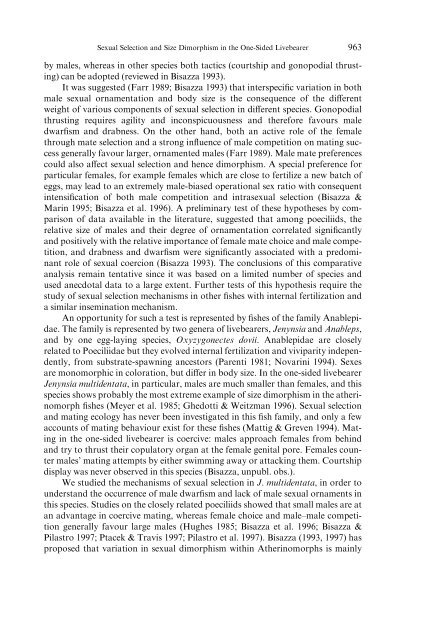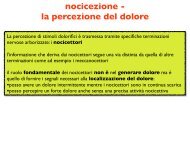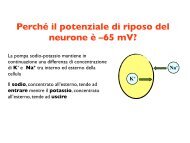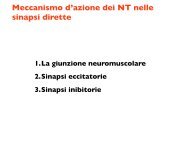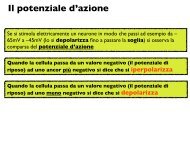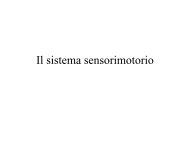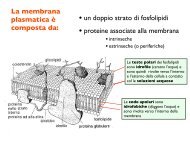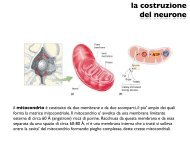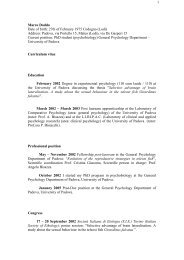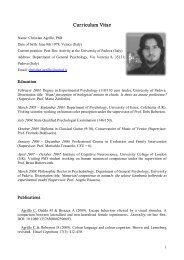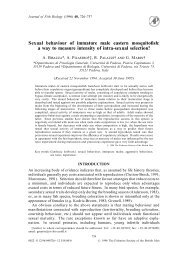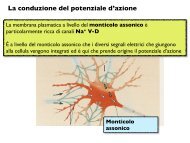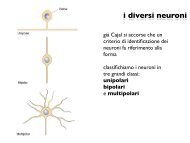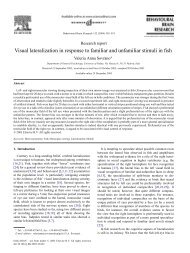Sexual Competition, Coercive Mating and Mate Assessment ... - CPRG
Sexual Competition, Coercive Mating and Mate Assessment ... - CPRG
Sexual Competition, Coercive Mating and Mate Assessment ... - CPRG
Create successful ePaper yourself
Turn your PDF publications into a flip-book with our unique Google optimized e-Paper software.
<strong>Sexual</strong> Selection <strong>and</strong> Size Dimorphism in the One-Sided Livebearer963by males, whereas in other species both tactics (courtship <strong>and</strong> gonopodial thrusting)can be adopted (reviewed in Bisazza 1993).It was suggested (Farr 1989; Bisazza 1993) that interspeci®c variation in bothmale sexual ornamentation <strong>and</strong> body size is the consequence of the di€erentweight of various components of sexual selection in di€erent species. Gonopodialthrusting requires agility <strong>and</strong> inconspicuousness <strong>and</strong> therefore favours maledwar®sm <strong>and</strong> drabness. On the other h<strong>and</strong>, both an active role of the femalethrough mate selection <strong>and</strong> a strong in¯uence of male competition on mating successgenerally favour larger, ornamented males (Farr 1989). Male mate preferencescould also a€ect sexual selection <strong>and</strong> hence dimorphism. A special preference forparticular females, for example females which are close to fertilize a new batch ofeggs, may lead to an extremely male-biased operational sex ratio with consequentintensi®cation of both male competition <strong>and</strong> intrasexual selection (Bisazza &Marin 1995; Bisazza et al. 1996). A preliminary test of these hypotheses by comparisonof data available in the literature, suggested that among poeciliids, therelative size of males <strong>and</strong> their degree of ornamentation correlated signi®cantly<strong>and</strong> positively with the relative importance of female mate choice <strong>and</strong> male competition,<strong>and</strong> drabness <strong>and</strong> dwar®sm were signi®cantly associated with a predominantrole of sexual coercion (Bisazza 1993). The conclusions of this comparativeanalysis remain tentative since it was based on a limited number of species <strong>and</strong>used anecdotal data to a large extent. Further tests of this hypothesis require thestudy of sexual selection mechanisms in other ®shes with internal fertilization <strong>and</strong>a similar insemination mechanism.An opportunity for such a test is represented by ®shes of the family Anablepidae.The family is represented by two genera of livebearers, Jenynsia <strong>and</strong> Anableps,<strong>and</strong> by one egg-laying species, Oxyzygonectes dovii. Anablepidae are closelyrelated to Poeciliidae but they evolved internal fertilization <strong>and</strong> viviparity independently,from substrate-spawning ancestors (Parenti 1981; Novarini 1994). Sexesare monomorphic in coloration, but di€er in body size. In the one-sided livebearerJenynsia multidentata, in particular, males are much smaller than females, <strong>and</strong> thisspecies shows probably the most extreme example of size dimorphism in the atherinomorph®shes (Meyer et al. 1985; Ghedotti & Weitzman 1996). <strong>Sexual</strong> selection<strong>and</strong> mating ecology has never been investigated in this ®sh family, <strong>and</strong> only a fewaccounts of mating behaviour exist for these ®shes (Mattig & Greven 1994). <strong>Mating</strong>in the one-sided livebearer is coercive: males approach females from behind<strong>and</strong> try to thrust their copulatory organ at the female genital pore. Females countermales' mating attempts by either swimming away or attacking them. Courtshipdisplay was never observed in this species (Bisazza, unpubl. obs.).We studied the mechanisms of sexual selection in J. multidentata, in order tounderst<strong>and</strong> the occurrence of male dwar®sm <strong>and</strong> lack of male sexual ornaments inthis species. Studies on the closely related poeciliids showed that small males are atan advantage in coercive mating, whereas female choice <strong>and</strong> male±male competitiongenerally favour large males (Hughes 1985; Bisazza et al. 1996; Bisazza &Pilastro 1997; Ptacek & Travis 1997; Pilastro et al. 1997). Bisazza (1993, 1997) hasproposed that variation in sexual dimorphism within Atherinomorphs is mainly


